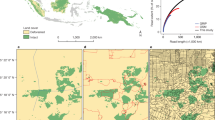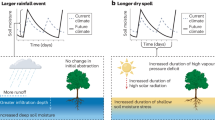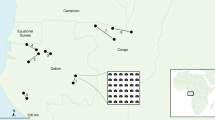Abstract
Restoration of degraded drylands is urgently needed to mitigate climate change, reverse desertification and secure livelihoods for the two billion people who live in these areas. Bold global targets have been set for dryland restoration to restore millions of hectares of degraded land. These targets have been questioned as overly ambitious, but without a global evaluation of successes and failures it is impossible to gauge feasibility. Here we examine restoration seeding outcomes across 174 sites on six continents, encompassing 594,065 observations of 671 plant species. Our findings suggest reasons for optimism. Seeding had a positive impact on species presence: in almost a third of all treatments, 100% of species seeded were growing at first monitoring. However, dryland restoration is risky: 17% of projects failed, with no establishment of any seeded species, and consistent declines were found in seeded species as projects matured. Across projects, higher seeding rates and larger seed sizes resulted in a greater probability of recruitment, with further influences on species success including site aridity, taxonomic identity and species life form. Our findings suggest that investigations examining these predictive factors will yield more effective and informed restoration decision-making.
This is a preview of subscription content, access via your institution
Access options
Access Nature and 54 other Nature Portfolio journals
Get Nature+, our best-value online-access subscription
$29.99 / 30 days
cancel any time
Subscribe to this journal
Receive 12 digital issues and online access to articles
$119.00 per year
only $9.92 per issue
Buy this article
- Purchase on Springer Link
- Instant access to full article PDF
Prices may be subject to local taxes which are calculated during checkout



Similar content being viewed by others
Data availability
Data housed in the GAZP database is a compilation of primary research data from active projects worldwide. The database is being launched as a publicly available tool, with some datasets requiring authorization by the individual contributor for full release due to internal data use agreements. To make it findable, accessible, interoperable and reusable (FAIR), the database requires extensive documentation and clear curation, which will be an ongoing effort as the project develops. The data used for this analysis that have been approved for release will be available, with clear metadata included, through github (https://github.com/paternogbc/ms_global_dryland-restoration, https://doi.org/10.5281/zenodo.5062861). For the full subset of data used for this analysis, including the restricted data, please contact the corresponding author.
Code availability
Code for all statistical models and plots is available on github (https://github.com/paternogbc/ms_global_dryland-restoration, https://doi.org/10.5281/zenodo.5062861). Note that the data housed publicly are not the full data set used in this analysis. To execute the code exactly as conducted here, please contact the corresponding author for the dataset used in the analysis.
Change history
28 July 2021
A Correction to this paper has been published: https://doi.org/10.1038/s41559-021-01544-7
References
Hobbs, R. J. et al. Restoration ecology: the challenge of social values and expectations. Front. Ecol. Environ. 2, 43–38 (2004).
Harris, J. A., Hobbs, R. J., Higgs, E. & Aronson, J. C. Ecological restoration and global climate change. Restor. Ecol. 14, 170–176 (2006).
Aronson, J. C. & Vallejo, R. in Restoration Ecology: The New Frontier (eds. van Andel, J. & Aronson, J. C.) (John Wiley & Sons, 2009).
Suding, K. et al. Committing to ecological restoration. Science 348, 638–640 (2015).
Plaza, C. et al. Soil resources and element stocks in drylands to face global issues. Sci. Rep. 8, 13788 (2018).
Aronson, J., Goodwin, N., Orlando, L., Eisenberg, C. & Cross, A. T. A world of possibilities: six restoration strategies to support the United Nation’s Decade on Ecosystem Restoration. Restor. Ecol. 28, 730–736 (2020).
Drylands and Land Degradation (IUCN, 2017).
Bainbridge, D. A. A Guide for Desert and Dryland Restoration: New Hope for Arid Lands (Island Press, 2012).
Millennium Ecosystem Assessment Findings (Millennium Ecosystem Assessment, 2005).
Reynolds, J. F., Maestre, F. T., Kemp, P. R., Stafford-Smith, D. M. & Lambin, E. in Terrestrial Ecosystems in a Changing World (eds. Canadell, J. G., Pataki, D. E. & Pitelka, L. F.) 247–257 (Springer, 2007); https://doi.org/10.1007/978-3-540-32730-1_20
Hoover, D. L. et al. Traversing the wasteland: a framework for assessing ecological threats to drylands. BioScience 70, 35–47 (2020).
Hardegree, S. P., Jones, T. A., Roundy, B. A., Shaw, N. L. & Monaco, T. A. in Conservation Benefits of Rangeland Practices 171–213 (United States Department of Agriculture, 2011).
James, J. J., Svejcar, T. J. & Rinella, M. J. Demographic processes limiting seedling recruitment in arid grassland restoration. J. Appl. Ecol. 48, 961–969 (2011).
Okin, G. S. et al. Connectivity in dryland landscapes: shifting concepts of spatial interactions. Front. Ecol. Environ. 13, 20–27 (2015).
Svejcar, L. N. & Kildisheva, O. A. The age of restoration: challenges presented by dryland systems. Plant Ecol. 218, 1–6 (2017).
Safriel, U. et al. Dryland Systems. Ecosystems and Human Well-being: Current State and Trends.: Findings of the Condition and Trends Working Group 623–662 (Millennium Ecosystem Assessment, 2005).
Ward, D. The Biology of Deserts (Oxford Univ. Press, 2016).
Li, Y., Chen, Y. & Li, Z. Dry/wet pattern changes in global dryland areas over the past six decades. Glob. Planet. Change 178, 184–192 (2019).
Prăvălie, R., Bandoc, G., Patriche, C. & Sternberg, T. Recent changes in global drylands: evidences from two major aridity databases. Catena 178, 209–231 (2019).
Yao, J. et al. Accelerated dryland expansion regulates future variability in dryland gross primary production. Nat. Commun. 11, 1665 (2020).
Aridity Zones and Dryland Populations: An Assessment of Population Levels in the World’s Drylands with Reference to Africa (UNSO/UNDP, 1997); http://digitallibrary.un.org/record/432312
van den Berg, L. & Kellner, K. Restoring degraded patches in a semi-arid rangeland of South Africa. J. Arid. Environ. 61, 497–511 (2005).
Valkó, O. et al. Cultural heritage and biodiversity conservation – plant introduction and practical restoration on ancient burial mounds. Nat. Conserv. 24, 65–80 (2018).
Louhaichi, M., Clifton, K. & Hassan, S. Direct seeding of Salsola vermiculata for rehabilitation of degraded arid and semi-arid rangelands. Range Manag. Agrofor. 35, 182–187 (2014).
Pérez, D. R., González, F., Ceballos, C., Oneto, M. E. & Aronson, J. Direct seeding and outplantings in drylands of Argentinean Patagonia: estimated costs, and prospects for large-scale restoration and rehabilitation. Restor. Ecol. 27, 1105–1116 (2019).
Kiehl, K., Kirmer, A., Donath, T. W., Rasran, L. & Hölzel, N. Species introduction in restoration projects: evaluation of different techniques for the establishment of semi-natural grasslands in Central and Northwestern Europe. Basic Appl. Ecol. 11, 285–299 (2010).
Miguel, M. F., Butterfield, H. S. & Lortie, C. J. A meta-analysis contrasting active versus passive restoration practices in dryland agricultural ecosystems. PeerJ 8, e10428 (2020).
Kildisheva, O. A., Erickson, T. E., Merritt, D. J. & Dixon, K. W. Setting the scene for dryland recovery: an overview and key findings from a workshop targeting seed-based restoration. Restor. Ecol. 24, S36–S42 (2016).
Lewandrowski, W., Erickson, T. E., Dixon, K. W. & Stevens, J. C. Increasing the germination envelope under water stress improves seedling emergence in two dominant grass species across different pulse rainfall events. J. Appl. Ecol. 54, 997–1007 (2017).
Ladouceur, E. & Shackelford, N. The power of data synthesis to shape the future of the restoration community and capacity. Restor. Ecol. 29, e13251 (2020).
Temperton, V. M., Baasch, A., von Gillhaussen, P. & Kirmer, A. in Foundations of Restoration Ecology (eds. Palmer, M. A., Zedler, J. B. & Falk, D. A.) 245–270 (Island Press/Center for Resource Economics, 2016); https://doi.org/10.5822/978-1-61091-698-1_9
Hulvey, K. B. & Aigner, P. A. Using filter-based community assembly models to improve restoration outcomes. J. Appl. Ecol. 51, 997–1005 (2014).
van Wilgen, B. W. The evolution of fire and invasive alien plant management practices in fynbos. S. Afr. J. Sci. 105, 335–342 (2009).
Arianoutsoua, M. & Vilà, M. Fire and invasive plant species in the Mediterranean Basin. Isr. J. Ecol. Evol. 58, 195–203 (2012).
Leger, E. A. & Baughman, O. W. What seeds to plant in the Great Basin? Comparing traits prioritized in native plant cultivars and releases with those that promote survival in the field. Nat. Areas. J. 35, 54–68 (2015).
Porensky, L. M., Vaughn, K. J. & Young, T. P. Can initial intraspecific spatial aggregation increase multi-year coexistence by creating temporal priority? Ecol. Appl. 22, 927–936 (2012).
FAOSTAT Statistical Database (Food and Agriculture Organization of the United Nations, 1997).
Balazs, K. R. et al. The right trait in the right place at the right time: matching traits to environment improves restoration outcomes. Ecol. Appl. 30, e02110 (2020).
Knutson, K. C. et al. Long-term effects of seeding after wildfire on vegetation in Great Basin shrubland ecosystems. J. Appl. Ecol. 51, 1414–1424 (2014).
Brown, C. S. & Bugg, R. L. Effects of established perennial grasses on introduction of native forbs in California. Restor. Ecol. 9, 38–48 (2001).
Porensky, L. M. et al. Arid old-field restoration: native perennial grasses suppress weeds and erosion, but also suppress native shrubs. Agric. Ecosyst. Environ. 184, 135–144 (2014).
Hardegree, S. P. et al. Hydrothermal assessment of temporal variability in seedbed microclimate. Rangel. Ecol. Manag. 66, 127–135 (2013).
Copeland, S. M. et al. Long-term trends in restoration and associated land treatments in the southwestern United States. Restor. Ecol. 26, 311–322 (2018).
Abella, S. R., Craig, D. J., Smith, S. D. & Newton, A. C. Identifying native vegetation for reducing exotic species during the restoration of desert ecosystems. Restor. Ecol. 20, 781–787 (2012).
Mulroy, T. W. & Rundel, P. W. Annual plants: adaptations to desert environments. BioScience 27, 109–114 (1977).
Leger, E. A., Goergen, E. M. & Forbis de Queiroz, T. Can native annual forbs reduce Bromus tectorum biomass and indirectly facilitate establishment of a native perennial grass? J. Arid. Environ. 102, 9–16 (2014).
Gutiérrez, J. R., Arancio, G. & Jaksic, F. M. Variation in vegetation and seed bank in a Chilean semi-arid community affected by ENSO 1997. J. Veg. Sci. 11, 641–648 (2000).
Venable, D. L. Bet hedging in a guild of desert annuals. Ecology 88, 1086–1090 (2007).
Baskin, C. C. Seed ecology: a diverse and vibrant field of study. Seed Sci. Res. 27, 61–64 (2017).
Padilla, F. M., Ortega, R., Sánchez, J. & Pugnaire, F. I. Rethinking species selection for restoration of arid shrublands. Basic Appl. Ecol. 10, 640–647 (2009).
SER International Primer on Ecological Restoration (SER, 2004).
The Plant List (WFO, 2013).
Seed Information Database (Royal Botanic Gardens, Kew, 2019).
Kattge, J. et al. TRY plant trait database – enhanced coverage and open access. Glob. Change Biol. 26, 119–188 (2020).
USDA, NRCS. The PLANTS Database (National Plant Data Team, 2020).
Western Australian Herbarium. FloraBase—the Western Australian Flora (Department of Biodiversity, Conservation and Attractions, 1998).
Fick, S. E. & Hijmans, R. J. Worldclim 2: new 1-km spatial resolution climate surfaces for global land areas. Int. J. Climatol. 37, 4302–4315 (2017).
Trabucco, A. & Zomer, R. J. Global Aridity Index and Potential Evapo-Transpiration (ET0) Climate Database, v3 (CGIAR Consortium for Spatial Information, 2019).
Barrow, C. J. World atlas of desertification (United Nations Environment Programme). Land Degrad. Dev. 3, 249–249 (1992).
Brooks, M. E. et al. glmmTMB balances speed and flexibility among packages for zero-inflated generalized linear mixed modeling. R J. 9, 378–400 (2017).
R Core Team. R: A Language and Environment for Statistical Computing (R Foundation for Statistical Computing, 2017).
Crawley, M. J. in The R Book 569–591 (Wiley, 2007).
Wortley, L., Hero, J.-M. & Howes, M. Evaluating ecological restoration success: a review of the literature. Restor. Ecol. 21, 537–543 (2013).
Acknowledgements
We would like to thank the supporters of the Global Arid Zone Project. The intellectual and energetic input of the network participants made this work possible. We also acknowledge the many employers and funding agencies that supported projects and the authors’ time in preparing this work and contributing data to the GAZP database. Please note that any use of trade, firm or product names is for descriptive purposes only and does not imply endorsement by the US Government.
Author information
Authors and Affiliations
Contributions
N. Shackelford conceived the work, conducted data collection, processing, analysis and writing. G.B.P. conducted processing, analysis, writing and compilation of supplementary material. D.E.W, K.L. Suding and T.E.E. conceived the work, assisted with data collection and guided the manuscript development and editing. E.A.L. and L.N.S. wrote, compiled and extensively edited the work. M.F.B., A.M.F. and P.A.H. assisted with data collection and edited the work. M.F.C., Q.G., A.K., D.J.L., K.Z.M., S.M.M., L.M.P., R.E.Q., P.T. and C.E.W. contributed to writing the work and providing feedback. A.A., M.A.B., E.A.B., N.B., O.W.B., C.B., M.E.L.B., C.S.B., C.M.B., P.J.B., E.C., P.J.C., A.C., C.D.C., K.W.D., B.D., J.D., S.D., J.E., E.E., H.L.F., S.E.F., M.G., E.G.R., P.J.G., P.A.G., B.H., P.M.H., J.J.J., J.J.-B., R.K., A.T.K., J.E.L., J.L., C.E.M., L.M.-M., T.M., S.J.M., T.A.M., A.M.M., J.A.N.-C., M.W.P., P.L.P., M.L.P., M.J.R., N. Saayman, M.C.S., T.P., E.W.S., K.L. Stuble, S.M.U., O.V., K.V., S.W., M.W. and Z.X. contributed data to the work.
Corresponding author
Ethics declarations
Competing interests
The authors declare no competing interests.
Additional information
Peer review information Nature Ecology & Evolution thanks the anonymous reviewers for their contribution to the peer review of this work. Peer reviewer reports are available.
Publisher’s note Springer Nature remains neutral with regard to jurisdictional claims in published maps and institutional affiliations.
Extended data
Extended Data Fig. 1 Distribution of native and exotic richness of seeded species.
(a) Frequency distribution of species richness across treatments. (b) Richness of seeded native species across regions. (c) Relationship between richness of seeded species and aridity, and (d) Richness of seeded exotic species across regions.
Extended Data Fig. 2 Frequency distribution of response and predictors for initial recruitment.
(a) Frequency distribution of species success (response) and (b) seeded and unseeded treatments (predictor).
Extended Data Fig. 3 Frequency distribution of response and predictors for Q3 (trends in vegetation development).
(a) Frequency distribution of species success (response), and predictors: (b) life form, (c) weed control), (d) aridity, (e) seed rate, (f) weeks since restoration and (g) seed mass (g).
Extended Data Fig. 4 Predicted species presence (%) across biotic and abiotic drivers.
(a) seed rate, (b) site aridity, (c) weed control, (d) time since restoration, and (e) seed mass. Solid lines (a, b, d, f) and dots (c) indicate population-level predictions (that is marginal means) conditioned on the fixed effects. Confidence bands and error bars represent 95% confidence intervals. Continuous predictors (a, b, d, e) are shown after centering and standardization (z-score transformation).
Extended Data Fig. 5 Frequency distribution of response and predictors for Q3 (North America only, trends in vegetation development).
(a) Frequency distribution of species success (response), and predictors: (b) life form, (c) weed control), (d) aridity, (e) seed rate, (f) weeks since restoration and (g) seed mass (g). Data was cropped to studies performed in North America.
Extended Data Fig. 6 Predicted species presence (%) across biotic and abiotic drivers (North America only).
(a) seed rate, (b) site aridity, (c) weed control, (d) time since restoration, and (e) seed mass. Solid lines (a, b, d, f) and dots (c) indicate population-level predictions (that is marginal means) conditioned on the fixed effects. Confidence bands and error bars represent 95% confidence intervals. Continuous predictors (a, b, d, e) are shown after centering and standardization (z-score transformation). Data was cropped to studies performed in North America.
Extended Data Fig. 7 Distribution of species success.
Average probability of success (presence) ± standard error across 488 angiosperms seeded species (a). Species that occurred in less than 3 treatments were excluded from analysis. Each point represents a single species. The color gradient indicates the average probability of presence ranging from zero (blue) to one (red). The distribution of average probabilities is represented in the histogram on panel (b).
Extended Data Fig. 8 Distribution of genus and family’s success.
Average probability of success (presence) ± standard error for genus (a) and families. Only families and genera with more than 3 species are shown. Each point represents a single species.
Extended Data Fig. 9 Distribution of genus and family’s success (North America).
Average probability of success (presence) ± standard error for genus (a) and families. Only families and genera with more than 3 species are shown. Each point represents a single species. Data was cropped to studies performed in North America.
Supplementary information
Supplementary Information
Supplementary Notes 1–4, Tables 1–9 and Figs. 1–28.
Rights and permissions
About this article
Cite this article
Shackelford, N., Paterno, G.B., Winkler, D.E. et al. Drivers of seedling establishment success in dryland restoration efforts. Nat Ecol Evol 5, 1283–1290 (2021). https://doi.org/10.1038/s41559-021-01510-3
Received:
Accepted:
Published:
Issue Date:
DOI: https://doi.org/10.1038/s41559-021-01510-3
This article is cited by
-
Shorebirds-driven trophic cascade helps restore coastal wetland multifunctionality
Nature Communications (2023)
-
Combining Rainwater Harvesting and Grass Reseeding to Revegetate Denuded African Semi-arid Landscapes
Anthropocene Science (2022)



